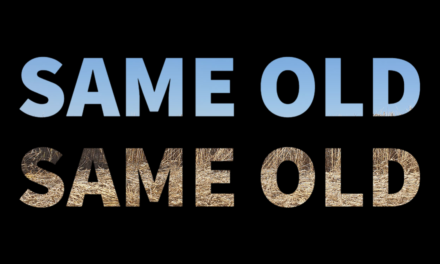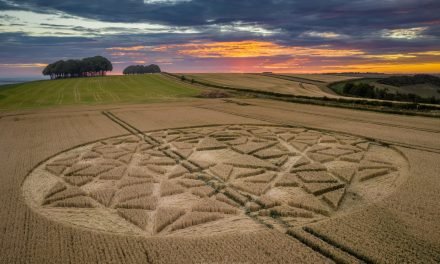
Ten Crop Circle Myths That Refuse To Die

INTRODUCTION
Hop on Facebook … sit in a pub … bump into people in a Wiltshire field at any time of year … turn the subject to crop circles and someone will, almost without fail, throw a dubious factoid somewhere into the conversation. You know the sort of thing: crop circles were invented by two drunks. No matter what you do in an attempt to address the inaccuracy, chances are nobody is going to listen. After all, that factoid is so ingrained in the public consciousness that, well, so many people can’t be wrong.
Here are ten of the most notable crop circle myths that refuse to go away, with more to follow at a later date:
1: Circle makers deliberately deceive the public by telling the world their creations are alien made.
The Croppie guesses this myth is partly based upon the intentions of original circle makers Dave Chorley and Doug Bower. In 1991 they told TODAY newspaper they’d started making crop circles to dupe ufologists into believing flying saucers had landed in the fields.
Thirty years on and this is a myth that persists. Part of this seems down to bitter, washed up, ex-circle makers who are looking for a stick to beat their supposed rivals with. They suggest that contemporary circle makers who stay quiet about their creations are essentially saying the aliens did it. Well … no … when someone stays quiet they’re not saying anything!
2: Circle makers frequent pubs where croppies meet.
It’s easy to imagine a circle maker sitting in one of the old crop circle pubs and listening in to the desires and hopes of croppies around a neighbouring table. The circle maker takes on board what he or she hears, goes home and plans a new formation in line with the expectations of his or her audience. If the croppies want, say, a new circle containing the underlying geometry of Stonehenge then they’ll get it.
Maybe situations like these did once occur but in the third decade of the 21st century the scenery is very different from the period between 1990 and 2010. The circle makers are vastly fewer in number and the formations less frequent. Furthermore, many rural communities have become increasingly intolerant of the phenomenon and a wise circle maker would be best served staying away from croppies.
3: There was a golden age of cerealogy where everyone used to get along.

Look at how they are all getting along nicely. A team of dedicated croppies working as a surveillance team for Nippon TV at East Field in 1991. Photograph via B1ackprojects
The Croppie terms anything between 1975 and 1991 as the ‘golden age’ of cerealogy, the good old days when Doug and Dave pulled the wool over the eyes of those who wanted to believe the circles were made by something other than human hands, feet and ingenuity. In some quarters a myth has grown to accompany this time; the idea that researchers and cerealogists all got along splendidly and were the very best of friends. It simply wasn’t so. One only has to read books by the likes of Pete Rendall, Jim Schnabel and John Macnish to see what was really going on: Colin Andrews sniped at Terence Meaden whilst the latter’s acolytes branded their foe Condrews. Ufologist Paul Fuller became embroiled in his own spat with Andrews, one that brought solicitors into the fray. Later, when Meadenite Peter Rendall published his own memoir of the era, Andrews went after him too. And just what was behind the parting-of-ways between Andrews and Busty Taylor?
4: The extent of human circle making has been deliberately withheld from the public.
This ploy neatly overlooks all those articles, books, television documentaries and features on what human circle makers do. (We’ve not even mentioned the ‘Men Who Fooled the World’ headline from TODAY newspaper in 1991!) If you want two classic places to start, begin with Round in Circles and The Field Guide by Jim Schabel and Jon Lundberg/Rob Irving respectively. All three were circle makers. Then proceed to the book Cropcircle Apocalypse, by John Macnish, and follow them up with the documentaries Croppies and Circlespeak. There are many other places to go. Yes, there are people who openly claim the paranormality of crop circles and related phenomena for their own gain, but they’re nowhere near as prominent or widespread as some people would have you believe. There’s more than enough information in the public domain for a genuine fact-hunter to find the answers. Some people just want you to believe there’s some big cover up going on as it suits their own agenda.
5: Circle makers work on demand for photographers.
This canard states certain photographers are paying circle makers to put down formations in specific places. However, these mafioso godfathers are parting with little more than loose change and, in turn, making thousands of pounds profit from the calendars, yearbooks and photographic prints they go on to sell. It perhaps seems believable until you understand that (a) there really is very little money to be made from crop circles these days — see below and click here for more— and (b) today’s circle makers are very independently minded and would have no interest in becoming beholden to anyone else, even if that third party was offering money (which they aren’t).
This rumour developed within the posts of the cesspit that was the Report A Crop Circle Formation group on Facebook. It was thoroughly ridiculous then, but given how often it was repeated it seemed to stick. Sadly, even now some people continue to believe this nonsense, particularly those new to the arena who’ll uncritically repeat the words of grumbling ex-circle makers.
6: Doug and Dave were alcoholics.

The Gaia pictogram … and all because ‘Mother is crying’. Photograph by Busty Taylor.
The Croppie doesn’t know what goes on behind closed doors but it seems sad that the memories of Doug Bower and Dave Chorley have been tarnished by lingering suggestions of alcoholism. There’s nothing in the public domain to indicate this was the case. What we do know is that the pair used to frequent The Percy Hobbs pub on the outskirts of Winchester, but that’s not an indicator of anything untoward in itself. It’s also been said by Bower that the ‘Gaia formation’ (at Cheesefoot Head, Hampshire, on 2 June 1990) took on a crooked appearance as Chorley was a little inebriated. Big deal. Perhaps this tale hasn’t helped the legendary duo, but The Croppie has seen zilch suggesting either Bower or Chorley had an issue with alcohol.
7: The Crab Wood crop circle was commissioned by Touchstone Pictures.
Who can forget the legendary formation that appeared at Crab Wood, near Winchester, Hampshire, in August 2002? It features an archetypal grey alien holding a disc encoded with a binary message. It’s certainly one of the most memorable and complex crop circles of all time but what were its origins? Nobody has claimed to have made it. That’s for certain.
However, according to a statement by Colin Andrews in 2019 the formation was a commission paid for by Touchstone Pictures to feature in the movie Signs. Andrews came to this conclusion following a discussion with one of the Circlemakers.org team. Colin claimed he was ‘given sufficient information to confirm [his] personal anger at’ Touchstone. Perhaps Andrews had been fed a yarn or was quick to come to his conclusion but the formation was not a commission.
The now defunct Crop Circle Wisdom website was next to comment on the formation. It pointed the finger at B1ackprojects, a circle making team it believed had been commissioned by Channel 4 in 2002 to create a crop circle for the Richard and Judy television show. Some have pointed out that the method of construction looks remarkably similar to that of the alien at Crab Wood. Whilst B1ackprojects were involved in this job, we understand from November 2024 correspondence with former circle maker Wil Russell that his Circlemakers.org team were the ones who had received the commission. We’ve no reason to disbelieve this.
Further doubt can be cast upon the idea that either Circlemakers.org or B1ackprojects were commissioned to make the Crab Wood formation. In November 2021 Wil Russell stated on Facebook that whilst the team ‘were in talks with the production company for the film Signs … [Touchstone Pictures] decided against using a circle to promote the film. That [Crab Wood] formation arrived at around that time and I think Colin [Andrews] has got his drinks mixed like a teenager guessing what spirits mix with what, in order to make a tasty drink – rum, tequila, Guinness anyone?’
8: Eighty percent of crop circles are man-made.
In 2000 cerealogist Colin Andrews stated ‘My findings at this time are that ample evidence exists that an estimated 80% of crop circles are man-made. On the other hand, 20% revealed no evidence of human involvement.’
Having been associated with numerous curious announcements through the years, Andrews made this one whilst believing the anomalous 20% were created by natural magnetic fields. Andrews has subsequently gone on to reassess his claim — he believes crop circles are made by people but are linked to other paranormal events — yet the myth sticks.
9: Genuine crop circles take the form of simple circles.

So simple, it can only be genuine? Headbourne Worthy, Hampshire; July 1996. Photograph by Colin Andrews.
If you spend time in the company of croppies you’ll regularly hear it said that simple circles are where the real mystery lies.
The sources here are twofold. First, cerealogist Terence Meaden used to push the line of circles being formed by electrically charged whirlwinds. The reckoning goes that whilst Meaden may have gotten it wrong when it came to the pictograms that first began to appear in 1990 — they incorporated straight lines — he may have been onto something before he was later shown incapable of distinguishing between manmade and ‘genuine’ circles. Second, Colin Andrews claimed in 2000 that somewhere in the region of 20% of crop circles may have been made by the Earth’s magnetic field, with the remaining 80% attributed to human ingenuity.
As things stand today there is absolutely no empirical evidence to suggest simple crop circles are any more or less to have been made by human hands than their more complex siblings.
10: The first crop circle was recorded in a 17th century pamphlet.
No. No. No … probably.
A 1678 pamphlet called The Mowing Devil: Or Strange News Out of Hartford-shire is constantly recycled as proof of one of the very earliest crop circles to have appeared in Britain. This almost certainly isn’t the case. The pamphlet tells of a farmer who refused to pay the asking rate of an agricultural worker to scythe his crops. The farmer went on to swear ‘That the Devil should Mow it rather than [the mower]. The Devil obliged and left the farmer with some rotting crop.
Croppies have been unable to resist the tale of the Mowing Devil as its illustration shows plants fallen into a rough oval type shape. Nonetheless, when was the last time you went into a crop circle and saw all the plants cut rather than flattened to the ground?





